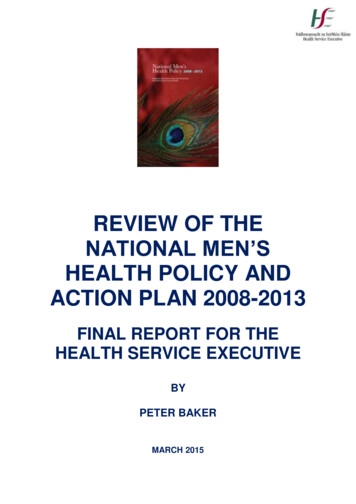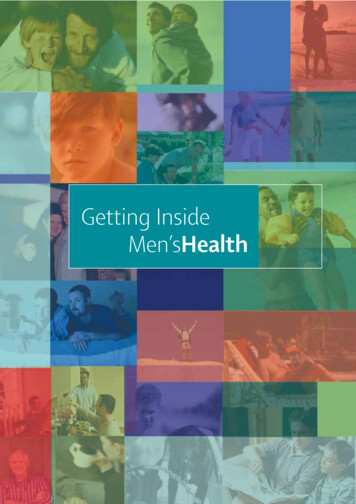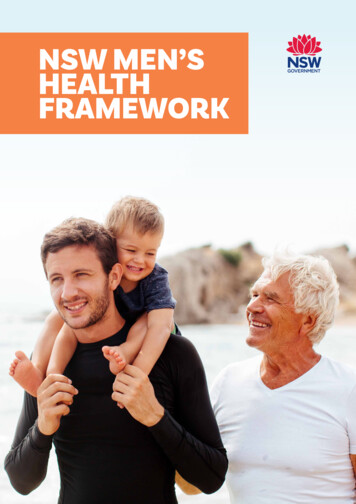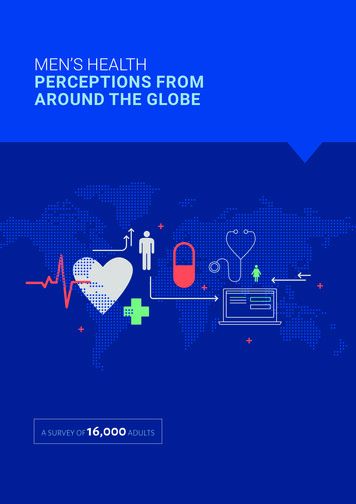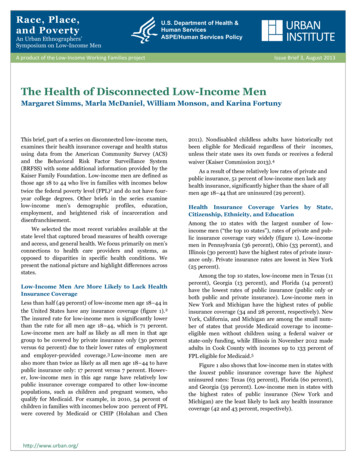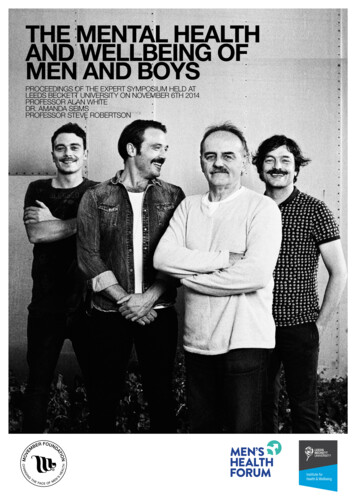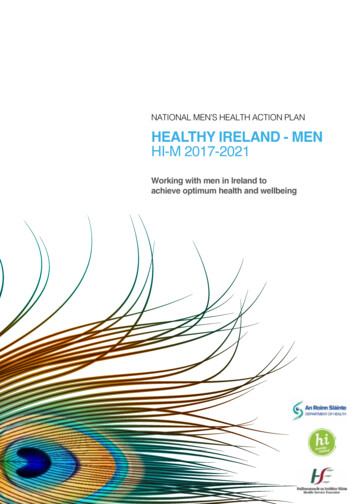
Transcription
Men’s HealthEducation, Awareness, andOutreachMen’s Health NetworkReaching men and boys where theylive, work, play, and praywww.menshealthnetwork.org
Education and Outreach Men's Health Network (MHN) A national DC based non-profit organization, founded in 1992, whosemission is to reach men and their families where theylive, work, play, and pray with health prevention messages andtools, screening programs, educational materials, advocacyopportunities, and patient navigation. Reaching Men, Boys, and Their Families Social MediaMen at WorkHealthy SundayCommunity PartnershipsSports/EntertainmentMedia CampaignsScreeningsSurveysConferences and SymposiaMen’s Health Network
Awareness Men’s Health Month June each year (www.MensHealthMonth.com) Men’s Health Week (Week ending on Father’s Day) A special awareness period created by Congress in 1994 Bob Dole & Bill Richardson in collaboration with MHN Signed into law by President ClintonOver 250 Governors and Mayors proclaimMen’s Health Month or Men’s Health WeekInternational Men’s Health WeekCongressional Health EventsTesticular Cancer Awareness (April each year)Prostate Cancer Awareness (September each year) Men’s Health Network
Men’s Health : The FactsMen’s Health Network
Current State of Men’s HealthLife Expectancy .57572.572.0706560 Men are half as likely to see a health care provider for a physicalexam as women. Men are more likely to be uninsured than women. Men are dying at higher rates than women for 9 of the top 10 causesof death.Men’s Health Network
Current State of Men’s .440.5 37.154.740.536.927.336.535.628.325.420.625.620.9 17.217.815.116.213.213.211.11320.75.80Death Rate, Both sexes, All ages – Death Rate, Male, All Ages – Death Rate, Female, All AgesVALUES ON NEXT SLIDETop 10 causes of death for 2014, age adjusted death rate per 100,000 populations.Source: National Center for Health Statistics. Health, United States, 2015. Hyattsville, MD. 2015. Retrieved June 3, 2016Men’s Health Network
Current State of Men’s HealthDiseaseDeath Rate, Both sexes,All AgesDeath Rate, Male, All AgesDeath Rate, Female, All AgesHeart167.0210.9131.8Malignant Neoplasms161.2192.9138.1Chronic lower 3Cerebrovascular disease36.536.935.6Alzheimer's disease25.420.628.3Diabetes mellitus20.925.617.2Influenza and pneumonia15.117.813.2Nephritis, nephritic syndrome13.216.211.1Intentional self harm13.020.75.8Top 10 causes of death for 2014, age adjusted, with death from diseases of theliver, suicide, and homicide also illustrated.Source: National Center for Health Statistics. Health, United States, 2015. Hyattsville, MD. 2015. Retrieved June 3, 2016Men’s Health Network
CardiovascularDiseaseand women among allethnic groups.Per 1,000 Person Years Leading killer of menApproximately 450,000men die of cardiovasculardisease each year.8070605040302010074.465.259.221.410.1 Approximately one inthree adult men havesome form ofcardiovascular 4AgeMenWomenIncidence of CVD by age and sex. Source: NHLBI4541.9 A man suffering fromcardiovascular diseasemay have ErectileDysfunction (ED) as asymptom.Per 1,000 Person 5 AgeMenWomenIncidence of heart failure by age and sex. Source: NHLBIMen’s Health Network
DiabetesDiabetes is a leading cause of heartdisease, strokes, kidneyfailure, blindness and amputations. 12 million American men aged 20 years or older have diabetes.Diabetes affects the body’s ability to turn food into theenergy it needs to function.Diabetes contributes to the deaths of over 200,000Americans each year.People with diabetes are more than 2X as likely todevelop heart disease or die from a heart attack.People diagnosed with diabetes have medicalexpenditures that are 2-3 times higher than patientswithout diabetes.A man suffering from diabetes may have ErectileDysfunction (ED) as a symptom.Men’s Health Network
CancerAccording to the American CancerSociety, the approximate lifetime risk ofdeveloping cancer is 1-in-2 for men. There are over 310,000 cancer related deathsin American men each year. Over the course of a lifetime, 1 in 2 men and 1in 3 women will get cancer. Prostate cancer is the most common cancer inAmerican men. Lung cancer is the most common fatal cancer inAmerican men. Cancer can strike anyone, at any age, but themajority of cases happen to men 55 and over.Men’s Health Network
Prostate Health BPH (prostate enlargement) A progressive condition which leads to: frequent urination,decreased urine stream,difficulty or pain while urinating, ora feeling of incomplete emptying of the bladderAffects half of men over age 50Affects about 90% of men by age 80Less than 50% of those men are diagnosedLess than 20% of men are being treatedProstate Cancer Prostate cancer is the most common cancer in American men Prostate and skin cancer continue tobe the most common cancers inAmerican men.Younger men may be more likely to have an aggressive form of prostate cancer1 in 7 men born today will be diagnosed in their lifetimeMore than 160,000 men are diagnosed each yearApproximately 27,000 men die of prostate cancer each year.African-American men are at increased riskProstatitis Inflammation of the prostate that may be caused by an infectionMen’s Health Network
Prostate Cancer2009-2013 deathrates.htmlRaceProstate and skin cancer continueto be the most common cancersin American men.Rate [1]Deaths [1]White (includes Hispanic)19.122,664White Non-Hispanic19.221,122White Hispanic17.71,506Black (includes Hispanic)44.24,686Hispanic (any race)17.11,555Amer. Indian/Alaskan Native (includes Hispanic)15.0123Asian or Pacific Islander (includes Hispanic)9.1436[1Age-Adjusted Death Rate, deaths per 100,000 (95% Confidence Interval)[2] Average Deaths Per YearMen’s Health Network
Testicular Cancer Testicular Cancer is the most common form ofcancer of men between the ages of 15-39 Risk Factors include: Undescended testicle(s), even if corrected Family history White Men are more likely to get Testicular Cancer thanHispanic, Asian-American, and African-American men Testicular cancer is less common among older andmiddle aged menMen’s Health Network
Sexual Health Your sex life is a reflection of your overall health – thehealthier you are, the better it will be. Erectile Dysfunction (ED) Caused by heart disease, diabetes, certainmedications, lifestyle, or other problems. 30 million American men experience ED Cardiovascular Disease and Diabetes Sexually Transmitted Infections (STIs / STDs) The more sexual partners you have, the greater yourrisk of getting an STI. Over 19 million new cases are diagnosed each year HIV/AIDS Chlamydia Gonorrhea Syphilis and more .Men’s Health Network
Mental Health Mental health is the psychological well-beingand satisfactory adjustment to society and tothe ordinary demands of life. Stress – Anxiety – Depression Factors Affecting Your Mental Health Death of a loved one Divorce or separation Loss of employment The birth of a child Being diagnosed with a serious illness Moving to a new job or home Natural disasters Your genes (some issues are hereditary)Men’s Health Network
Depression Depression Depression affects nearly 19 million American adults. Depression is under-diagnosed in men.Men are just as likely to be depressed as women, ifnot more so.Men are 4x as likely to commit suicide as women. Without treatment, symptoms of depression can lastweeks, months, or years. Depression is the leading cause of disability in theU.S., sidelining more people than backproblems, heart disease, or injuries.Men’s Health Network
Stress Symptoms Most common symptoms include: Headaches Stomach trouble, nausea, indigestion, constipation, ordiarrhea Shortness of breath Sleep issues—too little or too much Emotional symptoms: moodswings, anxiety, depression, apathy Behavioral symptoms: irritability, outbursts of anger, inabilityto concentrate More physical symptoms include: Muscle tensionFatigueBackachesColdsShoulder painDrug useMen’s Health Network
How much stress is too muchstress? Stress is: a physical and mental response to achallenging or threatening situation brought on by astressor When we are stressed, chemicals are released intoour blood causing physical changes including a fasterheartbeat and an increase in muscle tension Chronic Stress Coping with ongoing situations—daily job, family, orrelationship situations, chronic illness, financialdifficulty, discrimination Acute Stress A response to an immediate or life-threateningsituationMen’s Health Network
Anxiety Five most common conditions: Generalized Anxiety Disorder Obsessive Compulsive DisorderPanic Disorder Exaggerated worry and tensionAnticipation of disaster, health issues, money, family problems, ordifficulties at workA sudden onset of overwhelming terror – for no apparent reasonPost-Traumatic Stress Disorder (PTSD) An anxiety disorder caused by witnessing or experiencing atraumatic event Serious accident – Natural disaster – Terrorist attack – Anevent where you thought you were going to die – Shooting orbeing shot at in combat – Surviving a violent crime Social Phobia (or Social Anxiety Disorder)Men’s Health Network
Why Don’t Men Make Doctor Visits? Socialization plays a major part in men’s decisions tofrequent their physician Big boys don’t cry Work obligations Lack of health insurance Some men decide they will wait as long as possiblebefore visiting a doctor in hopes of getting better The biggest obstacle? Not making their health a top priority!Men’s Health Network
Top Excuses to Avoid Doctor Visits “I am healthy – there’s no reason for me to goto the doctor” “I have no time” “I don’t like doctors” “I am afraid of finding out that something iswrong with me” “I don’t need to go until I’m older”Recognize any of these?Men’s Health Network
Steps to Live a Longerand Healthier LifeMen’s Health Network
PreventionAmong men, more than one-half ofpremature deaths are preventable. Get an Annual Health Exam – Visit yourhealthcare provider each year. Know Your Numbers – PSA – Cholesterol –Glucose – Blood Pressure. Keep your own records. Do not rely on your health careprovider to say you are “okay” – Ask about your #s and keepthem in your records. Make Prevention a Priority – detect problems early. Ask Questions – it’s your body. Start Early – Don’t wait until you’re 50 to have your firsthealth exam since high school/college. Take advantage of free community health screenings oremployer offered health services and benefits. Involve your family in your health. Be a role model for your children.Men’s Health Network
Diet and Nutrition“You are what you eat” Over 60 percent of American men are overweight or obese. Men between the ages of 65 and 74 have the highestprevalence of obesity. Americans spend over 30 billion on diet programs eachyear.Men’s Health Network
Diet and NutritionOver 60 percent of adultAmerican men are overweight. The only truly effective way to lose weight is to reduce thenumber of calories you eat and get more exercise. Eat fruits, vegetables, whole grains, and fat-free or low-fatmilk and milk products. Eat lean meats, poultry,fish, beans, eggs, and nuts. Limit intake of saturated fat,trans fat, cholesterol, salt,and added sugars.Men’s Health Network
Exerciseand FitnessRegular physical activity is theclosest thing there is to amiracle drug. Before starting any exercise program, talk it over withyour health care provider for guidance. Start off easy – you may only be able to do fiveminutes per day. Gradually increase your workout capacity until you’reup to 20 minutes or more per day. Exercise at least two times per week. Any kind of activity – even mowing the lawn, washingyour car, or walking the dog is better than none.Men’s Health Network
Prostate HealthBPH (prostate enlargement) is the mostfrequent prostate condition in men 50 .Prostate Cancer is the #1 cancer in men. Early detection is the key Prostate Cancer Get a baseline prostate exam at age40, or earlierConsult your health care providerabout yearly exams after age 40Have regular safe sexAsk your health care provider aboutwww.ProstateHealthGuide.comother prevention tips BPH (benign prostatic hyperplasia) Progression can be slowed or stopped if treated early Prostatitis There are a number of treatment options Men’s Health Network
CardiovascularDiseaseApproximately 450,000men die of cardiovasculardisease each year. Cardiovascular disease is a blanket term thatincludes three major types of diseases: hypertension(high blood pressure), coronary heart disease, andstroke. Take these simple steps to protect yourself Have regular physicalsLose weight and choose a healthier lifestyleGet into a regular exercise routineLimit your alcohol and caffeine intakeReduce stressQuit smokingMen’s Health Network
DiabetesDiabetes is a leading cause of heartdisease, strokes, kidneyfailure, blindness and amputations. There is no cure for diabetes, however it can bemanaged and treated and about 90 percent of thetime, diabetes can be prevented before it starts. Keys to prevention and treatment Lose weight Get more exercise Control your blood pressure Eat a healthy, balanced dietMen’s Health Network
CancerOver 830,000 men are diagnosed withcancer each year and over 310,000 die of it. What you can do Recognize the risk factors – smoking, familyhistory, 55 or older, or cancer in the past. Early detection – notify your doctor if younotice anything unusual or abnormal. Reducing the risk – no tobacco, eat a healthydiet, stay active, and wear sun protection.Men’s Health Network
DepressionDepression is under-diagnosed inmen. Men are over four times morelikely than women to commit suicide. With proper diagnosis and treatment, the vastmajority of men with depression can be helped, andwill go on to lead normal, happy lives Depression in men is under-diagnosed Doctors are more likely to diagnose depression in women comparedwith men Treating depression starts with yourself Get some exercise – 20-30 minutes per daySpend some time with other peopleDo something you enjoy – even if you have to force yourselfDon’t make any decisions now – wait till you feel betterPrioritize – what needs to be done on any given day?Set realistic goalsBe patient with yourselfRead – “Your Head: An Owner’s Manual Understanding and OvercomingDepression, Anxiety and Stress” www.blueprintformenshealth.comMen’s Health Network
Coping with Stress / Anxiety Exercise, especially aerobic exerciseEat healthy foodsDon’t self-medicateEase up on caffeineGet some sleep—8 hours a nightTake deep breathsRelax and have some fun!Men’s Health Network
Remember:Some stress can be good! Some degree of stress canmake us more productiveand effective Eustress—the “good” stress Stress from happy events: Winning a race Birth of a baby Getting married Getting a promotion Buying a houseMen’s Health Network
See a Trend ? We have found that the best approaches to helpingmen lead a healthier and fuller lifestyle consist of afew simple steps: See your doctor regularly – Ask questions! Eat a healthy diet rich in fruits, vegetables, wholegrains, and low-fat foods Exercise for 20-30 minutes a day, 3-5 days/week Protect yourself from the sun Maintain a healthy weight Get a “good night’s sleep” Manage your stress Get help if you need it !Men’s Health Network
Important Web Sites Men's Health Network www.MensHealthNetwork.org Wear Blue for Men’s Health www.WearBlueForMen.com Men’s Health Resource Center www.MensHealthResourceCenter.com Men’s Health Month www.MensHealthMonth.org Testicular Cancer Awareness MonthTalking About Men’s lkingAboutMensHealth.com Prostate Cancer Awareness Month www.ProstateCancerAwarenessMonth.org Prostate Health Guide www.ProstateHealthGuide.com Men’s Health Library www.MensHealthLibrary.com Other important Internet resources www.hhs.gov www.cdc.gov www.nih.gov www.cancer.orgMen’s Health Network
Want to Learn More? For more information on these and other healthproblems which affect men, consult with a health careprovider or contact the Men’s Health Network.Men's Health NetworkWashington, ealthnetwork.org
Men's Health Month June each year (www.MensHealthMonth.com) Men's Health Week (Week ending on Father's Day) A special awareness period created by Congress in 1994 Bob Dole & Bill Richardson in collaboration with MHN Signed into law by President Clinton Over 250 Governors and Mayors proclaim


